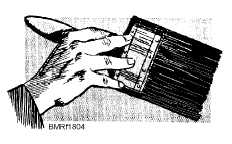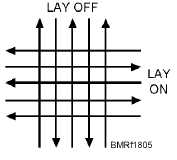brush; otherwise, paint will drip on the deck or other
surfaces and run down the handle.)
Hold the brush at right angles to the surface
being painted, with the ends of the bristles just
touching the surface. Lift the brush clear off the
surface when starting the return stroke. If the brush is
not held correctly and is not lifted, the painted surface
will be uneven, showing laps and spots and a daubed
appearance. Also, a brush that is held at any angle
other than a right angle will soon wear away at the
ends.
For complete and even coverage, follow the Navy
method and first lay on, and then lay off. “Laying on,”
means applying the paint first in long strokes in one
direction. “Laying off,” means crossing your first
strokes. The proper method is shown in figure 18-5. By
using the recommended Navy method and crossing
your strokes, you can distribute the paint evenly and
completely with a minimum amount of paint being
used.
Always paint the overhead first, working from the
corner that is farthest from the entrance of the
compartment. By painting the overhead first, you can
wipe drippings off the bulkhead without smearing the
bulkhead paint.
When overhead surfaces are being painted, sections
should normally be painted in a fore-and-aft direction;
beams, in an athwartship direction. But where sections
of the overhead contain many pipes running parallel
with the beams, it is often difficult to lay off the paint in a
fore-and-aft direction. In such situations, better results
are obtained by laying off the paint parallel with the
beams.
To avoid brush marks when finishing up an area you
have painted, use strokes directed toward the last
section finished, gradually lifting the brush near the end
of the stroke while the brush still is in motion. Every
time the brush touches the painted surface at the start of
a stroke, it leaves a mark. For this reason, never finish a
section by brushing toward the unpainted area. Instead,
always end up by brushing back toward the area already
painted.
When painting pipes, stanchions, narrow straps,
beams, and angles, lay the paint on diagonally, as shown
in figure 18-6. Lay off along the long dimension.
Always carry a rag for wiping up dripped or
smeared paint. Carefully remove loose bristles sticking
to the painted surface.
Cutting In
After you master the art of using a paintbrush
properly, learn to cut in. Cutting in is a simple procedure
that you can learn in a short time.
Suppose you have to cut in the angle between an
overhead and a bulkhead, as shown in figure 18-7. Start
at one corner. Hold your brush at an angle of about 76º to
80º from the bulkhead and about 10º from the overhead.
Draw your brush along in fairly long, smooth strokes.
This is one job where working slowly does not produce
better results. The slower you stroke, the wavier your
line will be.
Use of Rollers
The type of paint roller (fig. 18-8) used in the Navy
is equipped with a replaceable cylinder of soft fabric
over a solvent-resistant paper core. It rotates on the shaft
of a corrosion-resistant steel frame.
18-18
Figure 18-4.—Correct way to hold a brush.
Student Notes:
Figure 18-5.—Laying on and laying off.





